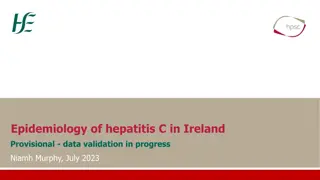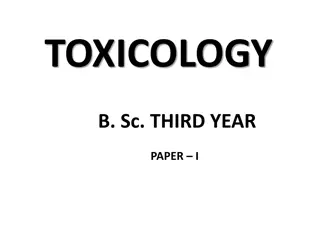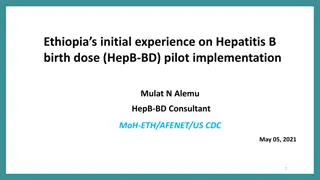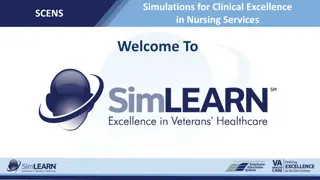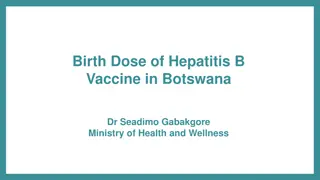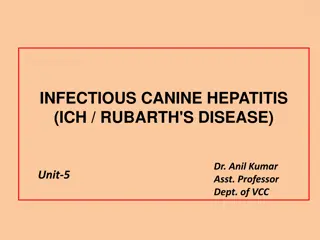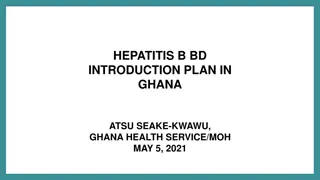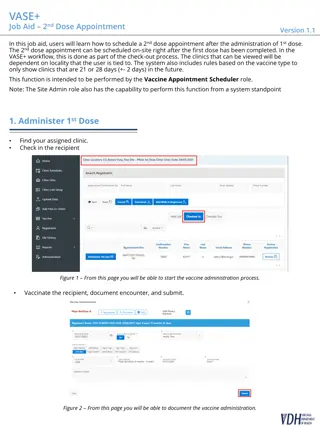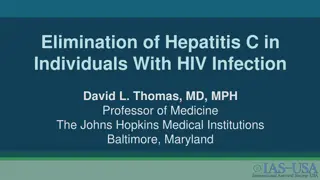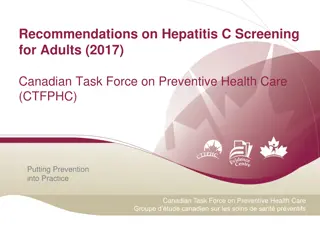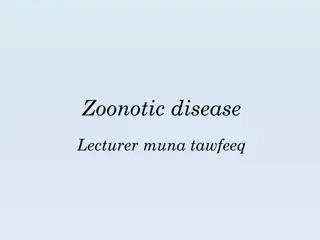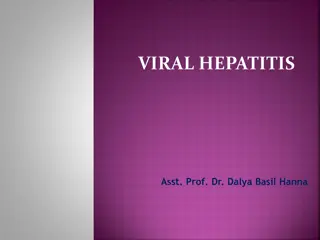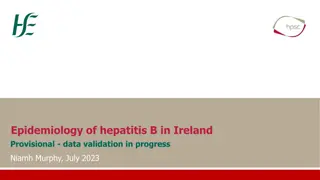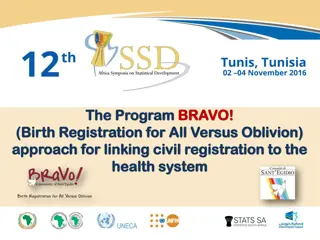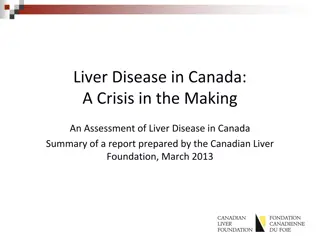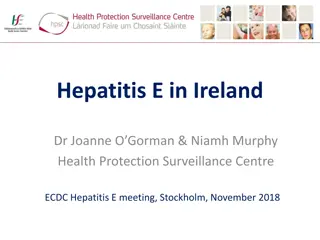Introduction of Hepatitis B Birth Dose in Mozambique: A Step Towards Comprehensive Prevention
Mozambique is gearing up to introduce the Hepatitis B birth dose as a strategic approach in its immunization program, aiming to tackle the high prevalence of HBV within the population, particularly among women and HIV-positive individuals. The country's existing policies on screening pregnant women for HBsAg and providing appropriate treatment guidelines reflect a proactive stance in combating the spread of Hepatitis B. With a focus on increasing vaccination coverage and integrating HBV prevention measures, Mozambique is set to enhance its public health efforts and safeguard vulnerable populations from this infectious disease.
Download Presentation

Please find below an Image/Link to download the presentation.
The content on the website is provided AS IS for your information and personal use only. It may not be sold, licensed, or shared on other websites without obtaining consent from the author.If you encounter any issues during the download, it is possible that the publisher has removed the file from their server.
You are allowed to download the files provided on this website for personal or commercial use, subject to the condition that they are used lawfully. All files are the property of their respective owners.
The content on the website is provided AS IS for your information and personal use only. It may not be sold, licensed, or shared on other websites without obtaining consent from the author.
E N D
Presentation Transcript
Plans for the Introduction of Hepatitis B Birth Dose in Mozambique Helga Guambe, MOH Mozambique
Background (1) Population size 30,853,842 people Total maternity wards 1,391 Fertility rate of 5.3% 1st ANC coverage 115% 4th ANC coverage 58,5% Live births 1,150,089 (2020) 85% institutional deliveries Prevalence of HIV (15-49 years) 13.2% (IMASIDA 2015) (SISMA 2020)
Background (2) Vaccination coverage levels for: HBV (pentavalent; DPT/Hep B/HIB ) vaccine available since 2004 as part of the immunization schedule for all children Vaccines given at birth (OPV0, BCG) OPV0- 107%, BCG 124% DPT1/Hep B/HIB coverage: 117% DPT 3/Hep B/HIB coverage: 108% (SISMA 2020)
Background (3) Hepatitis B birth dose is not provided in the country but has been approved by the national committee to be implemented in the country immunization However the Hep B birth dose is included in the National Plan for the Triple Elimination Transmission (HIV, Syphilis and Hep. B) of Vertical (SISMA 2020)
Background (4) Despite limited data, prevalence of HBV in Mozambique is thought to be high Estimated prevalence of HBsAg general population 7.2% women of reproductive age 10 % (2017 modeling report) ART naive HIV-positive 7.6% (95%CI 6.1-9.3) with 25% of all HBsAg+ having a HBV viral load (VL)> 8,617,488 IU/mL) Study conducted in a youth clinic (median age 16.6 years) in Maputo 12.2% (95%CI 10.5%-14.0%). Font: Public Health impact of a population based approach to HBV and HCV prevention and treatment in Mozambique
Hepatitis B Screening and Prevention Policy (1) 1. HBsAg screening of pregnant women National policy to screen all pregnant women, in the first ante-natal visit, preferably in the 1st trimester of pregnancy 2019
Hepatitis B Screening and Prevention Policy (2) 2. Treatment guidelines for infected pregnant women at ANC: HBV/HIV co-infected pregnant women, TDF/3TC/DTG as per national first line ARV protocol HBV mono-infected pregnant women evaluated for eligibility to start antiviral prophylaxis with TDF from 28 weeks of gestation or treatment with TDF or Entecavir (ETV) if necessary 2019
Hepatitis B Screening and Prevention Policy (3) 3. National PMTCT Triple Elimination Plan Objectives: 1. Integrate the birth dose of Hepatitis B into the national vaccination schedule; 2. Start HBsAg testing at ANCs as soon as a basic package is available for prevention, diagnosis and treatment of Hepatitis B; 3. Assess cost-effectiveness in the context of Mozambique on the use of antivirals to prevent HBV Vertical transmission; 4. Integrate Hepatitis B indicators into M&E system
HBV PMTCT Chamanculo ANC and Maternity
Chamanculo HBV PMTCT Project Strategy for preventing hepatitis B vertical transmission focused on use of tenofovir for pregnant women and introduction of birth-dose vaccine considering: 1. Mozambique is a LMIC with high transmission for HBV 2. There are patients who need Hepatitis B treatment following WHO recommendations, and are not receiving it 3. Hepatitis B vaccine birth dose is not included in national immunization schedule; MSF proposed an intervention using WHO supported recommendations to develop a feasible model of care as part of one stop model in MCH services
Chamanculo HBV PMTCT Project - Activities Hepatitis B testing during ante-natal care services Hepatitis B treatment and prophylaxis for pregnant women if need Hepatitis B newborn vaccination at birth before discharge from maternity; Testing partners and children for HBsAg positive pregnant women, and hepatitis vaccination if needed Designed and implement a workflow throughout the PMTCT cascade and linkage with MoH services for future intervention sustainability
HBV PMTCT Chamanculo ANC and Maternity November 2017 December 2020 HIV co- infected: 35% HBsAg pos rate: 3.5% HBV VL >200,000 HBeAg pos 44% HBV VL < 200,000 HBeAg pos 3.5% HBV BD: 80% MTCT: <1% (0.007%)
Achievements and Challenges HBsAg RDT integrated in ANC together with HIV and syphilis RDT HBV+ mothers referred to MSF team for HBeAg and HBV VL testing which are not available in MoH facilities availability of, at least HBeAg (RDT), in all ANC services HBV BD vaccination integrated in immediate post-natal care and immunization done by nurse in delivery room As Chamanculo is the only one maternity providing HBV BD vaccine, babies born out of this maternity didn t receive it. A system of calls and vaccine allocation in referral maternities was implemented not so succesfully availability of BD vaccine in all maternities Follow up after delivery was difficult as mother and babies are followed by other service (at risk consultation), then they need to come back to Maternity just for HBV consultation integration of HBV follow up in follow up routine consultation MoH standard registration tools (register and ANC books) adapted by adding stamps for testing and vaccination
Next Steps 1. Follow up with Global Fund s subsidy for: Acquisition of Rapid tests for HBsAg and HBeAg; Acquisition of TDF for prophylaxis and treatment; 2. Follow up with National Immunization program for submission of the proposal for financing request to GAVI 3. Develop national clinical protocols for implementation of PMTCT for Hepatitis B; 4. Revision of MCH M&E tools to integrate Hepatitis B indicators and variables.


